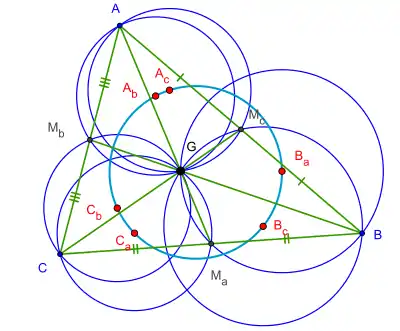
In Euclidean plane geometry, the van Lamoen circle is a special circle associated with any given triangle . It contains the circumcenters of the six triangles that are defined inside by its three medians.[1][2]
Specifically, let , , be the vertices of , and let be its centroid (the intersection of its three medians). Let , , and be the midpoints of the sidelines , , and , respectively. It turns out that the circumcenters of the six triangles , , , , , and lie on a common circle, which is the van Lamoen circle of .[2]
History
The van Lamoen circle is named after the mathematician Floor van Lamoen who posed it as a problem in 2000.[3][4] A proof was provided by Kin Y. Li in 2001,[4] and the editors of the Amer. Math. Monthly in 2002.[1][5]
Properties
The center of the van Lamoen circle is point in Clark Kimberling's comprehensive list of triangle centers.[1]
In 2003, Alexey Myakishev and Peter Y. Woo proved that the converse of the theorem is nearly true, in the following sense: let be any point in the triangle's interior, and , , and be its cevians, that is, the line segments that connect each vertex to and are extended until each meets the opposite side. Then the circumcenters of the six triangles , , , , , and lie on the same circle if and only if is the centroid of or its orthocenter (the intersection of its three altitudes).[6] A simpler proof of this result was given by Nguyen Minh Ha in 2005.[7]
See also
References
- 1 2 3 Kimberling, Clark, Encyclopedia of Triangle Centers, retrieved 2014-10-10. See X(1153) = Center of the van Lemoen circle.
- 1 2 Weisstein, Eric W., "van Lamoen circle", MathWorld, retrieved 2014-10-10
- ↑ van Lamoen, Floor (2000), Problem 10830, vol. 107, American Mathematical Monthly, p. 893
- 1 2 Li, Kin Y. (2001), "Concyclic problems" (PDF), Mathematical Excalibur, 6 (1): 1–2
- ↑ (2002), Solution to Problem 10830. American Mathematical Monthly, volume 109, pages 396-397.
- ↑ Myakishev, Alexey; Woo, Peter Y. (2003), "On the Circumcenters of Cevasix Configuration" (PDF), Forum Geometricorum, 3: 57–63
- ↑ Ha, N. M. (2005), "Another Proof of van Lamoen's Theorem and Its Converse" (PDF), Forum Geometricorum, 5: 127–132